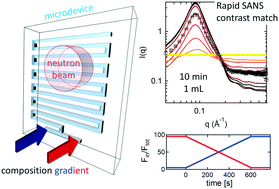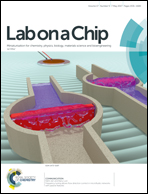Rapid contrast matching by microfluidic SANS†
Abstract
We report a microfluidic approach to perform small angle neutron scattering (SANS) measurements of contrast variation and matching, extensively employed in soft and biological matter research. We integrate a low scattering background microfluidic mixer and serpentine channel in a SANS beamline to yield a single phase, continuous flow, reconfigurable liquid cell. By contrast with conventional, sequential measurements of discrete (typically 4–6) solutions of varying isotopic solvent composition, our approach continually varies solution composition during SANS acquisition. We experimentally and computationally determine the effects of flow dispersion and neutron beam overillumination of microchannels in terms of the composition resolution and precision. The approach is demonstrated with model systems: H2O/D2O mixtures, a surfactant (sodium dodecyl sulfate, SDS), a triblock copolymer (pluronic F127), and silica nanoparticles (Ludox) in isotopic aqueous mixtures. The system is able to zoom into a composition window to refine contrast matching conditions, and robustly resolve solute structure and form factors by simultaneous fitting of scattering data with continuously varying contrast. We conclude by benchmarking our microflow-SANS with the discrete approach, in terms of volume required, composition resolution and (preparation and measurement) time required, proposing a leap forward in equilibrium, liquid solution phase mapping and contrast variation by SANS.



 Please wait while we load your content...
Please wait while we load your content...